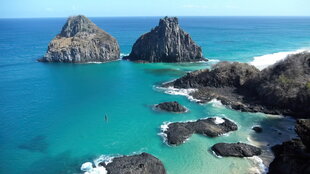Despite their small size, the volcanic islands of Fernando de Noronha have had a chaotic past. Discovered around 1500, probably on a Portuguese mapping expedition, this would have been one of the first places to have been discovered in the New World. They became an early focus on interest as a centre of trade in Brazilian hardwoods. They were occupied for a short time by the French East India Company, before being reclaimed by the Portuguese.
HMS Beagle and Charles Darwin visited the islands in 1832. It became a penal colony which then turned into a political prison which closed in 1957, but reopened in 1964 for Miguel Arraes, for refusing to resign as Pernambuco governor.
An airport was constructed at Fernando de Noronha in World War II to help with the allies in Africa. In 1950, the runway ended up being the emergency landing spot for a Trans-Canada flight. Two of the plane's engines malfunctioned and one set on fire. Fernando de Noronha, set far out into the Atlantic, was a God send for the pilot, crew and passengers.
More recently, 70% of the island’s archipelago was designated as national park and it is a UNESCO World Heritage Site due to its populations of whales, sharks, dolphins and other marine life. Fernando de Noronha has a particularly healthy population of Spinner Dolphins, which provide tremendous spotting as they leap and barrel roll at high speed.
The main island of Fernando de Noronha itself is 10 km by 3.5 km and accounts for over 90% of the area of the archipelago. It experiences a tropical savannah climate similar to that of central Brazil and central Africa, with a rainy season enduring from February to July; but with a very consistent temperature across the year. The influx of warm water from the South Equatorial Current provides warm waters and great visibility for diving.
Despite its status as a World Heritage Site, significant deforestation in the 1800s and the introduction of invasive species, most significantly domestic cats and Tegu Lizards, have changed the environment here in recent years. However, two national parks which are present on the island enforce protection of a range of its bird species, Green Sea Turtles, Phyllogorgia dilatate coral reef and some fish species, aiming to reduce the impact of threats to them.

Fernando de Noronha is a popular place amongst Brazilians, so the best accommodation and flights can book up far in advance. Please plan with us as far ahead as possible.

